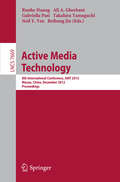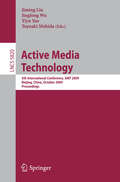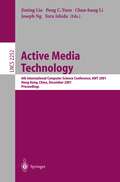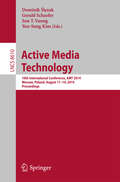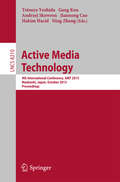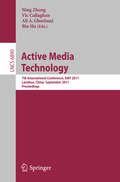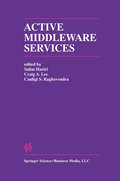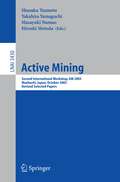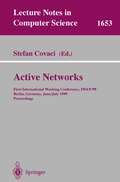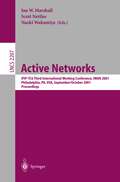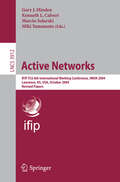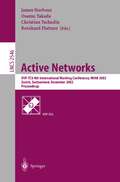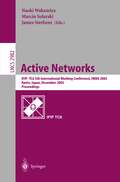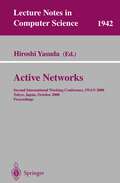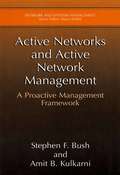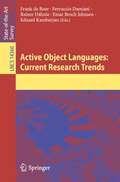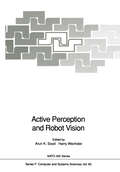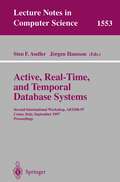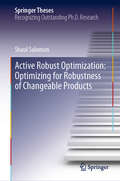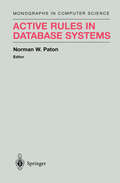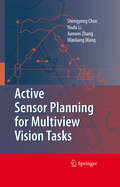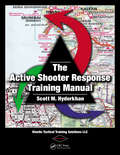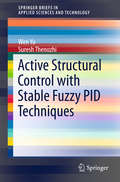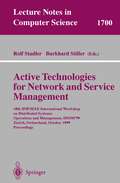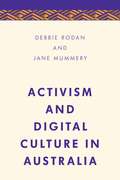- Table View
- List View
Active Media Technology: 8th International Conference, AMT 2012, Macau, China, December 4-7, 2012, Proceedings (Lecture Notes in Computer Science #7669)
by Runhe Huang Ali A. Ghorbani Takahira Yamaguchi Gabriella Pasi Neil Yen Beihong JinThis book constitutes the refereed proceedings of the 8th International Conference on Active Media Technology, AMT 2012, held in Macau, China, in December 2012. The 65 revised full papers were carefully reviewed and selected from a numerous submissions. The papers are organized in topical sections on awareness multi-agent systems, data mining, ontology mining, web reasoning, social applications of active media, human-centered computing, personalization and adaptation, smart digital art and e-learning.
Active Media Technology: 5th International Conference, AMT 2009, Beijing, China, October 22-24, 2009, Proceedings (Lecture Notes in Computer Science #5820)
by Jiming Liu Jinglong Wu Yiyu Y. Yao Toyoaki NishidaThis book constitutes the refereed proceedings of the 5th International Conference on Active Media Technology, AMT 2009, held in Beijing, China, in October 2009. The 47 revised full papers and the 6 keynote talks were carefully reviewed and selected. The papers reflect the shared forum for researchers and practitioniers from diverse fields, such as computer science, information technology, artificial intelligence, media engineering, economics, data mining, data and knowledge engineering, intelligent agent technology, human computer interaction, complex systems and systems science. The book offers new insights into the main research challenges and development of AMT by revealing the interplay between the studies of human informatics and research of informatics on the Web/Internet, mobile and wireless centric intelligent information processing systems.
Active Media Technology: 6th International Computer Science Conference, AMT 2001, Hong Kong, China, December 18-20, 2001. Proceedings (Lecture Notes in Computer Science #2252)
by Jiming Liu Pong C. Yuen Chung-Hung Li Joseph Ng Toru IshidaThe past few years have witnessed rapid scienti?c and technological devel- ments in human-centered, seamless computing environments, interfaces, de- ces, and systems with applications ranging from business and communication to entertainment and learning. These developments are collectively best charac- rized as Active Media Technology (AMT), a new area of information technology and computer science that emphasizes the proactive, seamless roles of interfaces and systems as well as new digital media in all aspects of human life. This - lume contains the papers presented at the Sixth International Computer Science Conference: Active Media Technology (AMT 2001), the ?rst conference of its kind, capturing the state of research and development in AMT and the latest architectures, prototypes, tools, and ?elded systems that demonstrate or enable AMT. The volume is organized into the following eight parts: I. Smart Digital - dia; II. Web Personalization; III. Active Interfaces; IV. Autonomous Agent - proaches; V. Facial Image Processing; VI. AMT-Supported Commerce, Business, Learning, and Health Care; VII. Tools and Techniques; and VIII. Algorithms.
Active Media Technology: 10th International Conference, AMT 2014, Warsaw, Poland, August 11-14, 2014, Proceedings (Lecture Notes in Computer Science #8610)
by Dominik Slezak Gerald Schaefer Son T. Vuong Yoo-Sung KimThis book constitutes the proceedings of the 10th International Conference on Active Media Technology, AMT 2014, held in Warsaw, Poland, in August 2014, held as part of the 2014 Web Intelligence Congress, WIC 2014. The 47 full papers presented were carefully reviewed and selected from numerous submissions. The topics of these papers encompass active computer systems; interactive systems and applications of AMT-based systems; active media machine learning and data mining techniques; AMT for the semantic web; social networks and cognitive foundations.
Active Media Technology: 9th International Conference, AMT 2013, Maebashi, Japan, October 29-31, 2013. Proceedings (Lecture Notes in Computer Science #8210)
by Tetsuya Yoshida Gang Kou Andrzej Skowron Jiannong Cao Hakim Hacid Ning ZhongThis book constitutes the refereed proceedings of the 9th International Conference on Active Media Technology, AMT 2013, held in Maebashi, Japan, in October 2013. The 26 revised full papers presented together with 2 short papers, 16 workshop papers, and 12 special session papers were carefully reviewed and selected from numerous submissions. The papers are organized in topical sections on active computer systems, interactive systems, and application of AMT based systems; active media machine learning and data mining techniques; AMT for semantic web, social networks, and cognitive foundations. Additionally, the main topic of the workshop papers is: intelligence for strategic foresight; and for the special session papers: technologies and theories of narrative; evolutionary computation and its application; and intelligent media search techniques.
Active Media Technology: 7th International Conference, AMT 2011, Lanzhou, China, September 7-9, 2011. Proceedings (Lecture Notes in Computer Science #6890)
by Ning Zhong Vic Callaghan Ali A. Ghorbani Bin HuThis book constitutes the refereed proceedings of the 7th International Conference on Active Media Technology, AMT 2011, held in Lanzhou, China, in September 2011. The 30 revised full papers and 6 keynote talks were carefully reviewed and selected for inclusion in the book. They are grouped in topcial sections on data mining and pattern analysis in active media; active human-Web interaction and social media; active Web intelligence applications; active multi-agent and network systems; as well as technology intelligence.
Active Middleware Services: From the Proceedings of the 2nd Annual Workshop on Active Middleware Services (The Springer International Series in Engineering and Computer Science #583)
by Salim Hariri Craig A. Lee Cauligi S. RaghavendraThe papers in this volume were presented at the Second Annual Work shop on Active Middleware Services and were selected for inclusion here by the Editors. The AMS workshop was organized with support from both the National Science Foundation and the CAT center at the Uni versity of Arizona, and was held in Pittsburgh, Pennsylvania, on August 1, 2000, in conjunction with the 9th IEEE International Symposium on High Performance Distributed Computing (HPDC-9). The explosive growth of Internet-based applications and the prolifer ation of networking technologies has been transforming most areas of computer science and engineering as well as computational science and commercial application areas. This opens an outstanding opportunity to explore new, Internet-oriented software technologies that will open new research and application opportunities not only for the multimedia and commercial world, but also for the scientific and high-performance computing applications community. Two emerging technologies - agents and active networks - allow increased programmability to enable bring ing new services to Internet based applications. The AMS workshop presented research results and working papers in the areas of active net works, mobile and intelligent agents, software tools for high performance distributed computing, network operating systems, and application pro gramming models and environments. The success of an endeavor such as this depends on the contributions of many individuals. We would like to thank Dr. Frederica Darema and the NSF for sponsoring the workshop.
Active Mining: Second International Workshop, AM 2003, Maebashi, Japan, October 28, 2003, Revised Selected Papers (Lecture Notes in Computer Science #3430)
by Shusaku Tsumoto Takahira Yamaguchi Masayuki Numao Hiroshi MotodaActive Networks: First International Working Conference, IWAN'99, Berlin, Germany, June 30 - July 2, 1999, Proceedings (Lecture Notes in Computer Science #1653)
by Stefan CovaciThis book constitutes the refereed proceedings of the First International Workshop on Active Networks, IWAN'99, held in Berlin, Germany in June/July 1999.The 30 revised full papers presented were carefully reviewed and selected from a total of 80 submissions. The book is divided in sections on networks architectures, platforms, active management and control, and security. All in all, this book provides a unique state-of-the-art account of architectural aspects, technologies, and prototype systems that will impact the way future networked businesses will be created and managed.
Active Networks: IFIP-TC6 Third International Working Conference, IWAN 2001, Philadelphia, PA, USA, September 30-October 2, 2001. Proceedings (Lecture Notes in Computer Science #2207)
by Ian W. Marshall Scott Nettles Naoki WakamiyaThis volume of the LNCS series contains the papers accepted for presentation at the Third IFIP international working conference on active networks (IWAN 2001). The workshop was held at the Sheraton University City Hotel, in Philadelphia USA, and was hosted by the University of Pennsylvania. Active networks aim to ease the introduction of network services by adding dynamic programmability to network devices such as routers, and making aspects of the programmability accessible to users. Active networks research has focused on the development and testing of active techniques, that enable dynamic programmability in a networked environment. These techniques have a wide variety of applications. At IWAN 2001 we aimed to bring together members of the various communities using active and related techniques, and provide a forum for discussion and collaboration, involving researchers, developers, and potential users. Papers presented at IWAN 2001 covered the application of active techniques to many aspects of network based communication, including active multicast, active QoS, active security, active GRIDs, and active management. In addition, there were papers on architectures, language, and API issues. Although there were only 22 submissions, the standard of the 10 accepted papers was very high. This indicated clearly a substantial amount of ongoing high quality research in active networking, despite the current unfavorable economic conditions in the telecommunications industry. The papers also demonstrated that the research is genuinely global, and justifies an international workshop of this type. We would like to thank all the authors who submitted their work.
Active Networks: IFIP TC6 6th International Working Conference, IWAN 2004, Lawrence, KS, USA, October 27-29, 2004, Revised Papers (Lecture Notes in Computer Science #3912)
by Gary J. MindenThis book constitutes the thoroughly refereed post-proceedings of the IFIP-TC6 6th Annual International Working Conference on Active Networks, IWAN 2004, held in Lawrence, KS, USA in October 2004. The 14 revised full papers presented together with one invited paper are organized in topical sections on active networking systems, active networking security, active networking applications, mobile active networks, and active networking management.
Active Networks: IFIP-TC6 4th International Working Conference, IWAN 2002, Zurich, Switzerland, December 4-6, 2002, Proceedings (Lecture Notes in Computer Science #2546)
by James P. G. Sterbenz Osamu Takada Christian Tschudin Bernhard PlattnerActive Networks: IFIP TC6 5th International Workshop, IWAN 2003, Kyoto, Japan, December 10-12, 2003, Revised Papers (Lecture Notes in Computer Science #2982)
by Naoki Wakamiya Marcin Solarski James SterbenzThis volume of the LNCS series contains the proceedings of the 5th Internat- nal Working Conference on Active Networks (IWAN 2003) held in the ancient cultural city of Kyoto, Japan. This year we received 73 submissions. The increasing number indicates that Active Networks continues to be an attractive ?eld of research. Through - reful reviewing and discussion, our program committee decided to fully accept 21 papers. Three papers were conditionally accepted, and were included after shepherding by members of the technical program committee. This volume thus includes these 24 papers which were presented at IWAN 2003. Additional papers were presented in a poster session at the conference. The best paper award went to Kenneth L. Calvert, James N. Gri?oen, - jati Imam, and Jiangbo Li (University of Kentucky) for “Challenges in Imp- menting an ESP Service,” which begins these proceedings and which began the papers in the High Performance & Network Processors session. Papers in these proceedings are organized into seven sessions: High-Level Active Network - plications, Low-Level Active Network Applications, Self-Organization of Active Services, Management in Active Networks, Experiences with Service Engin- ring for Active Networks, and Selected Topics in Active Networks, ranging from risk management to context-aware handover and peer-to-peer communications.
Active Networks: Second International Working Conference, IWAN 2000 Tokyo, Japan, October 16-18, 2000 Proceedings (Lecture Notes in Computer Science #1942)
by Hiroshi YasudaThis book constitutes the refereed proceedings of the Second International Working Conference on Active Networks, IWAN 200, held in Tokyo, Japan in October 2000. The 30 revised full papers presented were carefully reviewed and selected from numerous submissions. The book offers topical sections on architecture, multicast, quality of service (QoS), applications, management, service architecture, and mobile IP.
Active Networks and Active Network Management: A Proactive Management Framework (Network and Systems Management)
by Stephen F. Bush Amit B. KulkarniActive networking is an exciting new paradigm in digital networking that has the potential to revolutionize the manner in which communication takes place. It is an emerging technology, one in which new ideas are constantly being formulated and new topics of research are springing up even as this book is being written. This technology is very likely to appeal to a broad spectrum of users from academia and industry. Therefore, this book was written in a way that enables all these groups to understand the impact of active networking in their sphere of interest. Information services managers, network administrators, and e-commerce developers would like to know the potential benefits of the new technology to their businesses, networks, and applications. The book introduces the basic active networking paradigm and its potential impacts on the future of information handling in general and on communications in particular. This is useful for forward-looking businesses that wish to actively participate in the development of active networks and ensure a head start in the integration of the technology in their future products, be they applications or networks. Areas in which active networking is likely to make significant impact are identified, and the reader is pointed to any related ongoing research efforts in the area. The book also provides a deeper insight into the active networking model for students and researchers, who seek challenging topics that define or extend frontiers of the technology. It describes basic components of the model, explains some of the terms used by the active networking community, and provides the reader with taxonomy of the research being conducted at the time this book was written. Current efforts are classified based on typical research areas such as mobility, security, and management. The intent is to introduce the serious reader to the background regarding some of the models adopted by the community, to outline outstanding issues concerning active networking, and to provide a snapshot of the fast-changing landscape in active networking research. Management is a very important issue in active networks because of its open nature. The latter half of the book explains the architectural concepts of a model for managing active networks and the motivation for a reference model that addresses limitations of the current network management framework by leveraging the powerful features of active networking to develop an integrated framework. It also describes a novel application enabled by active network technology called the Active Virtual Network Management Prediction (AVNMP) algorithm. AVNMP is a pro-active management system; in other words, it provides the ability to solve a potential problem before it impacts the system by modeling network devices within the network itself and running that model ahead of real time.
Active Object Languages: Current Research Trends (Lecture Notes in Computer Science #14360)
by Frank De Boer Ferruccio Damiani Reiner Hähnle Einar Broch Johnsen Eduard KamburjanActive Objects are a programming paradigm that supports a non-competitive, data-driven concurrency model. This renders active object languages to be well-suited for simulation, data race-free programming, and formal verification. Concepts from active objects made their way into languages such as Rust, ABS, Akka, JavaScript, and Go. This is the first comprehensive state-of-art overview on the subject, the invited contributions are written by experts in the areas of distributed systems, formal methods, and programming languages.
Active Perception and Robot Vision (NATO ASI Subseries F: #83)
by Arun K. Sood Harry WechslerIntelligent robotics has become the focus of extensive research activity. This effort has been motivated by the wide variety of applications that can benefit from the developments. These applications often involve mobile robots, multiple robots working and interacting in the same work area, and operations in hazardous environments like nuclear power plants. Applications in the consumer and service sectors are also attracting interest. These applications have highlighted the importance of performance, safety, reliability, and fault tolerance. This volume is a selection of papers from a NATO Advanced Study Institute held in July 1989 with a focus on active perception and robot vision. The papers deal with such issues as motion understanding, 3-D data analysis, error minimization, object and environment modeling, object detection and recognition, parallel and real-time vision, and data fusion. The paradigm underlying the papers is that robotic systems require repeated and hierarchical application of the perception-planning-action cycle. The primary focus of the papers is the perception part of the cycle. Issues related to complete implementations are also discussed.
Active, Real-Time, and Temporal Database Systems: Second International Workshop, ARTDB'97, Como, Italy, September 8-9, 1997, Proceedings (Lecture Notes in Computer Science #1553)
by Sten F. Andler Jörgen HanssonDatabase systems of the next generation are likely to be inherently very complex due to the diversity of requirements placed on them. Incorporating active, real time, and temporal virtues in one database system is an arduous effort but is also a commend able one. This book presents the proceedings of the Second International Workshop on Active, Real Time, and Temporal Database Systems (ARTDB 97), held in Como, Milan, in September 1997. The aim of the workshop was to bring researchers together from the active and real time research communities, and to examine the current state of the art in active, real time, and temporal database systems. This book offers a collection of papers presented at the ARTDB 97 workshop. The papers, many of them representing proficient and tenable results, illuminate the feasibility of building database system supporting reactive behavior, while enforcing timeliness and predictability. The book contains nine papers carefully reviewed and accepted by the program committee, three invited papers written by prominent researchers in the field, and two summaries of the panel discussions held at the workshop. The program committee received seventeen submissions, where each submission was reviewed by at least three program committee members. The two panel sessions focused on predictability issues and on practical experience of active, real time, and temporal database systems. The ARTDB 97 workshop was held in cooperation with the IEEE Technical Committees on Real Time Systems and Complexity in Computing, and the ACM Special Interest Group on Manipulation of Data.
Active Robust Optimization: Optimizing for Robustness of Changeable Products (Springer Theses)
by Shaul SalomonThis book presents a novel framework, known as Active Robust Optimization, which provides the tools for evaluating, comparing and optimizing changeable products. Since any product that can change its configuration during normal operation may be considered a “changeable product,” the framework is widely applicable. Further, the methodology enables designers to use adaptability to deal with uncertainties and so avoid over-conservative designs. Offering a comprehensive overview of the framework, including its unique features, such as its ability to optimally respond to uncertain situations, the book also defines a new class of optimization problem and examines the effects of changes in various parameters on their solution. Lastly, it discusses innovative approaches for solving the problem and demonstrates these with two examples from different fields in engineering design: optimization of an optical table and optimization of a gearbox.
Active Rules in Database Systems (Monographs in Computer Science)
by Norman W. PatonA timely survey of the field from the point of view of some of the subject's most active researchers. Divided into several parts organized by theme, the book first covers the underlying methodology regarding active rules, followed by formal specification, rule analysis, performance analysis, and support tools. It then moves on to the implementation of active rules in a number of commercial systems, before concluding with applications and future directions for research. All researchers in databases will find this a valuable overview of the topic.
Active Sensor Planning for Multiview Vision Tasks
by Shengyong Chen Y. F. Li Jianwei Zhang Wanliang WangThis unique book explores the important issues in studying for active visual perception. The book’s eleven chapters draw on recent important work in robot vision over ten years, particularly in the use of new concepts. Implementation examples are provided with theoretical methods for testing in a real robot system. With these optimal sensor planning strategies, this book will give the robot vision system the adaptability needed in many practical applications.
The Active Shooter Response Training Manual
by Scott M. HyderkhanThe modern Active Shooter Response (ASR) has continually evolved since its inception approximately a decade ago. This change is necessary to continue improvement on the ASR mission. The Active Shooter Response Training Manual provides police personnel with the skills necessary to respond successfully to any active shooter situation. Using establish
Active Structural Control with Stable Fuzzy PID Techniques (SpringerBriefs in Applied Sciences and Technology)
by Wen Yu Suresh ThenozhiThis book presents a detailed discussion of intelligent techniques to measure the displacement of buildings when they are subjected to vibration. It shows how these techniques are used to control active devices that can reduce vibration 60–80% more effectively than widely used passive anti-seismic systems. After introducing various structural control devices and building-modeling and active structural control methods, the authors propose offset cancellation and high-pass filtering techniques to solve some common problems of building-displacement measurement using accelerometers. The most popular control algorithms in industrial settings, PD/PID controllers, are then analyzed and then combined with fuzzy compensation. The stability of this combination is proven with standard weight-training algorithms. These conditions provide explicit methods for selecting PD/PID controllers. Finally, fuzzy-logic and sliding-mode control are applied to the control of wind-induced vibration. The methods described are supported by reports of experimental studies on a two-story building prototype. This book is a valuable resource for academic researchers interested in the effects of control and mechatronic devices within buildings, or those studying the principles of vibration reduction. Practicing engineers working on the design and construction of any sort of high-rise or vulnerable building and concerned with the effects of either wind or seismic disturbances benefit from the efficacy of the methods proposed.
Active Technologies for Network and Service Management: 10th IFIP/IEEE International Workshop on Distributed Systems: Operations and Management, DSOM'99, Zurich, Switzerland, October 11-13, 1999, Proceedings (Lecture Notes in Computer Science #1700)
by Rolf Stadler Burkhard StillerThis volume of the Lecture Notes in Computer Science series contains all papers accepted for presentation at the 10th IFIP/IEEE International Workshop on Distributed Systems: Operations and Management (DSOM’99), which took place at the ETH Zürich in Switzerland and was hosted by the Computer Engineering and Networking Laboratory, TIK. DSOM’99 is the tenth workshop in a series of annual workshops, and Zürich is proud to host this 10th anniversary of the IEEE/IFIP workshop. DSOM’99 follows highly successful meetings, the most recent of which took place in Delaware, U.S.A. (DSOM'98), Sydney, Australia (DSOM'97), and L’Aquila, Italy (DSOM'96). DSOM workshops attempt to bring together researchers from the area of network and service management in both industry and academia to discuss recent advancements and to foster further growth in this ?eld. In contrast to the larger management symposia IM (In- grated Network Management) and NOMS (Network Operations and Management S- posium), DSOM workshops follow a single-track program, in order to stimulate interaction and active participation. The speci?c focus of DSOM’99 is “Active Technologies for Network and Service Management,” re?ecting the current developments in the ?eld of active and program- ble networks, and about half of the papers in this workshop fall within this category.
Activism And Digital Culture In Australia (PDF)
by Jane Mummery Debbie RodanActivists use digital as well as mainstream media tools to attract supporters, advertise their campaigns, and raise awareness of issues in the broader community. Activism and Digital Culture in Australia examines the use of digital tools and culture by Australian and international activist organisations to facilitate public engagement, participation and deliberation in issues and advance social change. In particular the book engages media studies, cultural studies, social theory and various ethical and political philosophical perspectives to examine the use of digital multi-platform tools by activist organisations and advocates for social change to a) disseminate information and raise public awareness; b) invoke, inform and shape public debate through the provision of information and invocation of affect; and c) garner public support (including funding) for issues and for associated social change. Engaging both qualitative and quantitative approaches, these case studies will demonstrate the richness of digital culture for activism and advocacy, examining the use by activist organisations of such digital media tools as apps, blogging, Facebook, RSS, Twitter, and YouTube. The shows that digital culture offers productive mechanisms and spaces for the reshaping of society itself to take more of a participatory role in progressing social change.
